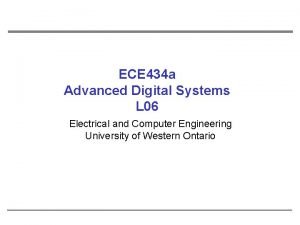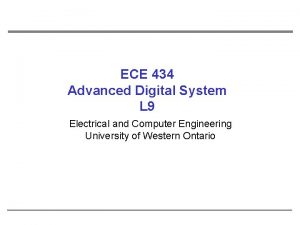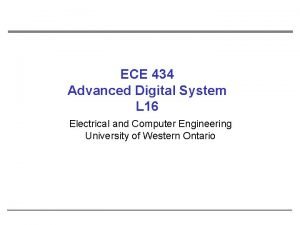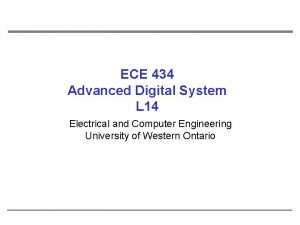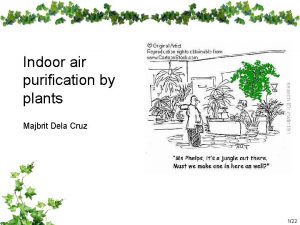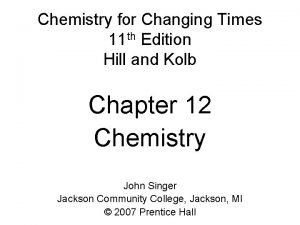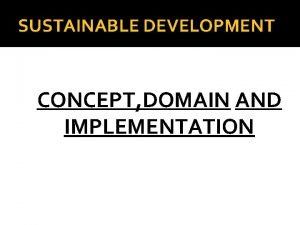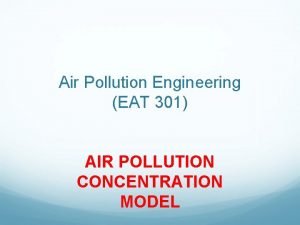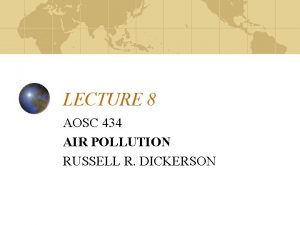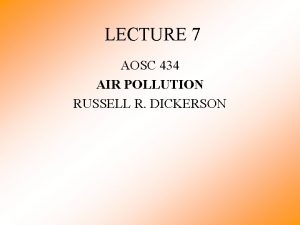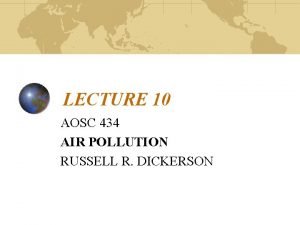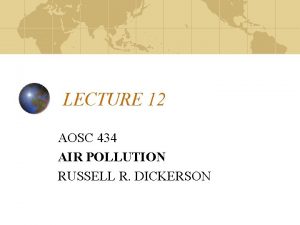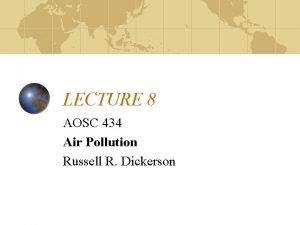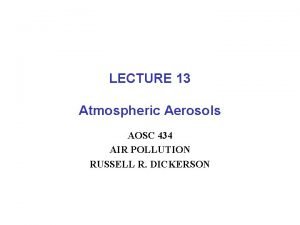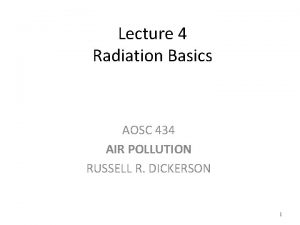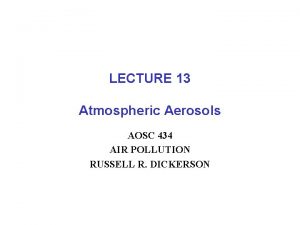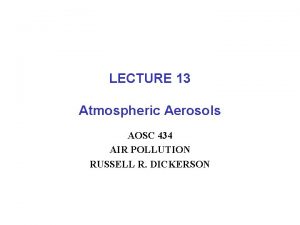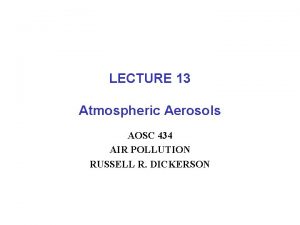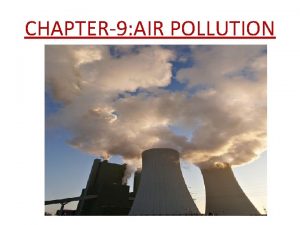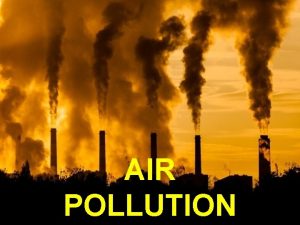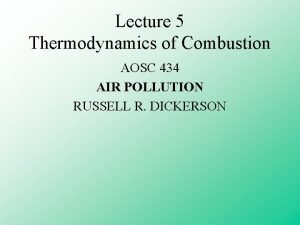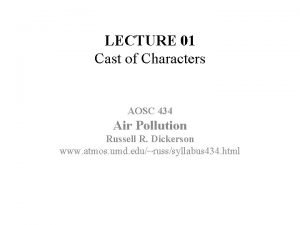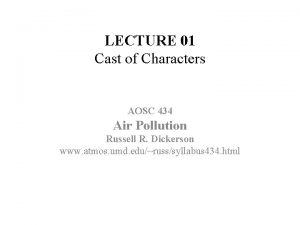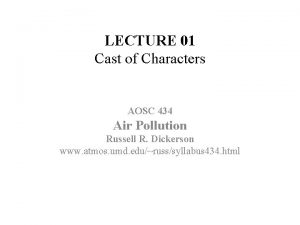LECTURE 11 AOSC 434 AIR POLLUTION RUSSELL R




![d[N]/dt = k 1[O] [N 2] - k-1 [NO][N] - k 2[N][O 2] + d[N]/dt = k 1[O] [N 2] - k-1 [NO][N] - k 2[N][O 2] +](https://slidetodoc.com/presentation_image/5ae1f023840eb39270f343485e2f30e6/image-5.jpg)
![From I and II 2[O]k 1[N 2] - (k-1 k-2[NO]2/ k 2[O 2]) d[NO]/dt From I and II 2[O]k 1[N 2] - (k-1 k-2[NO]2/ k 2[O 2]) d[NO]/dt](https://slidetodoc.com/presentation_image/5ae1f023840eb39270f343485e2f30e6/image-6.jpg)



![For combustion, how long does it take to reach the equilibrium [NO]? Depends on For combustion, how long does it take to reach the equilibrium [NO]? Depends on](https://slidetodoc.com/presentation_image/5ae1f023840eb39270f343485e2f30e6/image-10.jpg)













- Slides: 23

LECTURE 11 AOSC 434 AIR POLLUTION RUSSELL R. DICKERSON

GASEOUS POLLUTION AND PHOTOCHEMICAL SMOG NO Formation The Automobile Seinfeld Chapt. 3 Wark and Warner Chapt. 10 Exhaust Emissions Nitric Oxide, NO The formation of NO is controlled by kinetics, not thermodynamic equilibrium. High temperatures favor the formation of NO, and as the exhaust gases cool the NO is frozen out because the reformation of N 2 and O 2 is slow. See Wark and Warner section 8. 4. We know how to calculate [NO]eq. Our objective here is to derive an expression for the rate at which [NO] approaches the equilibrium concentration, [NO]eq.

The Zeldovich Mechanism (1946) N 2 + O 2 ↔ 2 NO Derive an expression for the rate of NO formation. Equilibrium Calculation Keq = exp(- G /RT) = (PNO )2/(PN 2 PO 2) The limit to the formation of NO is the slow rate of N 2 dissociation, which is hindered by a large positive G. Oxygen dissociates more readily. N 2 2 N Go = +217. 8 kcal/mole Keq = 10 -158 O 2 2 O Go = +110. 8 kcal/mole Keq = 10 -81

We can represent the formation of NO as a two step process. O + N 2 ↔ NO + N (1) N + O 2 ↔ NO + O (2) -----------N 2 + O 2 ↔ 2 NO (NET) d[NO]/dt = k 1[O][N 2] - k-1 [NO][N] + k 2 [N][O 2] - k-2 [NO][O] (I) We will assume that N is in steady state. This is not the same as assuming it is in thermodynamic equilibrium.
![dNdt k 1O N 2 k1 NON k 2NO 2 d[N]/dt = k 1[O] [N 2] - k-1 [NO][N] - k 2[N][O 2] +](https://slidetodoc.com/presentation_image/5ae1f023840eb39270f343485e2f30e6/image-5.jpg)
d[N]/dt = k 1[O] [N 2] - k-1 [NO][N] - k 2[N][O 2] + k-2 [NO][O] k 1[O] [N 2] + k-2[NO][O] [N]ss = ---------------- k-1[NO] + k 2[O 2] [O] { k 1[N 2] + k-2[NO] } [N]ss = ----------------(II) k-1[NO] + k 2[O 2]
![From I and II 2Ok 1N 2 k1 k2NO2 k 2O 2 dNOdt From I and II 2[O]k 1[N 2] - (k-1 k-2[NO]2/ k 2[O 2]) d[NO]/dt](https://slidetodoc.com/presentation_image/5ae1f023840eb39270f343485e2f30e6/image-6.jpg)
From I and II 2[O]k 1[N 2] - (k-1 k-2[NO]2/ k 2[O 2]) d[NO]/dt = -----------------------(III) 1 + (k-1[NO] / k-2[O 2]) Where: k 1 = 1. 3 E-10 exp (-38000/T) cm 3 s-1 k 1 (2400 K) = 1. 7 E-17 cm 3 s-1 k-1 = 3. 4 E-11 cm 3 s-1 k-1 (240 K) = 3. 4 E -11 cm 3 s-1 k 2 = 1. 5 E-11 exp(-3600/T) cm 3 s-1 k 2 (2400 K) = 3. 3 E-12 cm 3 s-1 k-2 = 2. 5 E -15 T exp(-19500/T) cm 3 s-1 k-2 (2400 K) = 2 E-15 cm 3 s-1

In a qualitative sense, at combustion temperature Reaction 1 is fast; Reaction 2 is fast if there is any O 2 around, and Reactions -1 and -2 are slow. So the formation of NO is much faster than the destruction. As the temperature drops, O atoms react with each other to reform O 2, preventing Reaction -2 from removing much NO: O + M O 2 + M† The superscript dagger represents translational kinetic energy. In deriving a quantitative expression for the rate of formation of NO, the following relations will prove useful. Remember that rate constants are much harder to measure than thermodynamic properties, thus thermodynamic data are generally better (more accurate) than kinetic data. Anywhere we can substitute Keq for k, we will.

K 1 K 2 = (k 1 /k-1)(k 2/k-2 ) = (PNO )2/{ PN 2 PO 2} 2 k 1[O][N 2] {1 - ([NO]2 / Keq [N 2] [O 2])} d[NO]/dt = ------------------------ 1 + (k 1[NO] / k 2 [O 2]) (IV)

For a given temperature, Equation IV can be integrated to yield an expression for the concentration of NO as a function of time, but this is a tedious process. See Wark and Warner, p. 384. The result is: [NO]t = [NO]eq ( 1 - (exp(-Mt))1/2 ) Where [NO]eq is the equilibrium concentration of NO and M = 5. 7 E 15 T -1 P 1/2 exp(-58400/T) s-1 Note that M is a strong function of temperature, but not pressure. We have assumed that Reactions 1 and 2 control, that the temperature is constant throughout the process, and that N 2 and O 2 are present at a ratio of 40: 1. The actual process is very complicated because the temperature does not remain constant.
![For combustion how long does it take to reach the equilibrium NO Depends on For combustion, how long does it take to reach the equilibrium [NO]? Depends on](https://slidetodoc.com/presentation_image/5ae1f023840eb39270f343485e2f30e6/image-10.jpg)
For combustion, how long does it take to reach the equilibrium [NO]? Depends on temperature. If you can move the exhaust gas out fast enough NO does not have a chance to form.

How much NO is made in a power plant? Depends on time and temperature.

CONCLUSIONS Tuning to Reduce Automotive Pollution Emissions The kinetics of CO formation and destruction are rapid. The emission of CO follows thermodynamic equilibrium, and is regulated by the temperature at the end of combustion. With slow kinetics, NO is seldom in thermodynamic equilibrium, and the emission is regulated more by the maximum combustion temperature. A) Air-Fuel-Mixture AFR POWER ECONOMY CO/HC NOx LEAN LOW HIGH RICH HIGH LOW

B) Compression Increases power and reduces CO, but puts structural demands on the engine, and requires higher octane fuel to prevent knocking. Higher octane fuel cannot be produced with lead or the catalytic converters will be poisoned. High octane fuel without lead is more reactive with respect to photochemical ozone formation. C) Timing For maximum power, combustion should take place at the point of maximum compression, therefore the spark is usually advanced, and occurs before top dead center. But if a low octane fuel is used with an engine that has the spark advanced for maximum power, knocking occurs. By retarding the spark, the octane demand of the engine is reduced. Retarding the spark also lowers both the maximum temperature and the end temperature of combustion, reducing both NO and CO production.

D) Exhaust gas Recycling Adding exhaust, rich in relatively inert CO 2, N 2 O and N 2, to the combustion mixture reduces the temperature enough to help reduce NO production.

De. NOx Plant Air preheater Boiler EP Gas preheater FGD plant Ammonia De. NOx Water reactor EP Limestone Slag : SICK MAIHAK Gmb. H Coal Air Ashes : SICK process automation gypsum : C. Blackmore/M. Davidson AQE

Application SCR De. NOx Plant Why do we want to measure? With the help of a catalyst, NO and NH 3 react to N 2 and water: 4 NO + 4 NH 3 + O 2 4 N 2 + 6 H 2 O n NO measurement is important for the process control: n a) raw gas before catalyst : to calculate the NH 3 injection rate n based on the “NO load” n b) check catalyst efficiency and NH 3 -trim 1 : SICK MAIHAK Gmb. H : SICK process automation : C. Blackmore/M. Davidson AQE


dieselclass. com/Engine%20 Files/SCR%20 PPT%2010 -09. pdf





Urea CO(NH)2 Hydrolysis: OC(NH)2 + H 2 O -> CO 2 + 2 NH 3
 Chapter 12 air section 1 what causes air pollution
Chapter 12 air section 1 what causes air pollution Chapter 12 air section 1 what causes air pollution
Chapter 12 air section 1 what causes air pollution Hubungan air dengan tanah
Hubungan air dengan tanah Ece 434
Ece 434 Anatomy team 434
Anatomy team 434 Ece 434
Ece 434 Aatcc 172
Aatcc 172 Ece 434
Ece 434 Anatomy team 434
Anatomy team 434 434 x 2
434 x 2 Kj 434 allah adalah kasih dan sumber kasih
Kj 434 allah adalah kasih dan sumber kasih Ece 434
Ece 434 01:640:244 lecture notes - lecture 15: plat, idah, farad
01:640:244 lecture notes - lecture 15: plat, idah, farad Indoor air pollutants
Indoor air pollutants Aim of air pollution
Aim of air pollution Effects of environmental pollution
Effects of environmental pollution Air pollution wildfires
Air pollution wildfires Brainpop air pollution
Brainpop air pollution Two sources of air pollution
Two sources of air pollution Air pollution definition
Air pollution definition Air pollution box model example
Air pollution box model example Air pollution specialist
Air pollution specialist Introduction about air pollution
Introduction about air pollution Air pollution
Air pollution



